Organisational Change and Leadership Styles
VerifiedAdded on 2023/06/10
|10
|2539
|482
AI Summary
This article discusses the significance of organisational change and the role of transformational leadership in motivating employees to sustain business in a competitive environment. It also explores different leadership styles, effective learning and communication strategies for successful change management. The article emphasizes the importance of feedback, judgement, personal power, and role modelling in leadership performance and organizational culture. The reflection section highlights the need for improving communication skills, body language, and self-management skills for better leadership performance.
Contribute Materials
Your contribution can guide someone’s learning journey. Share your
documents today.
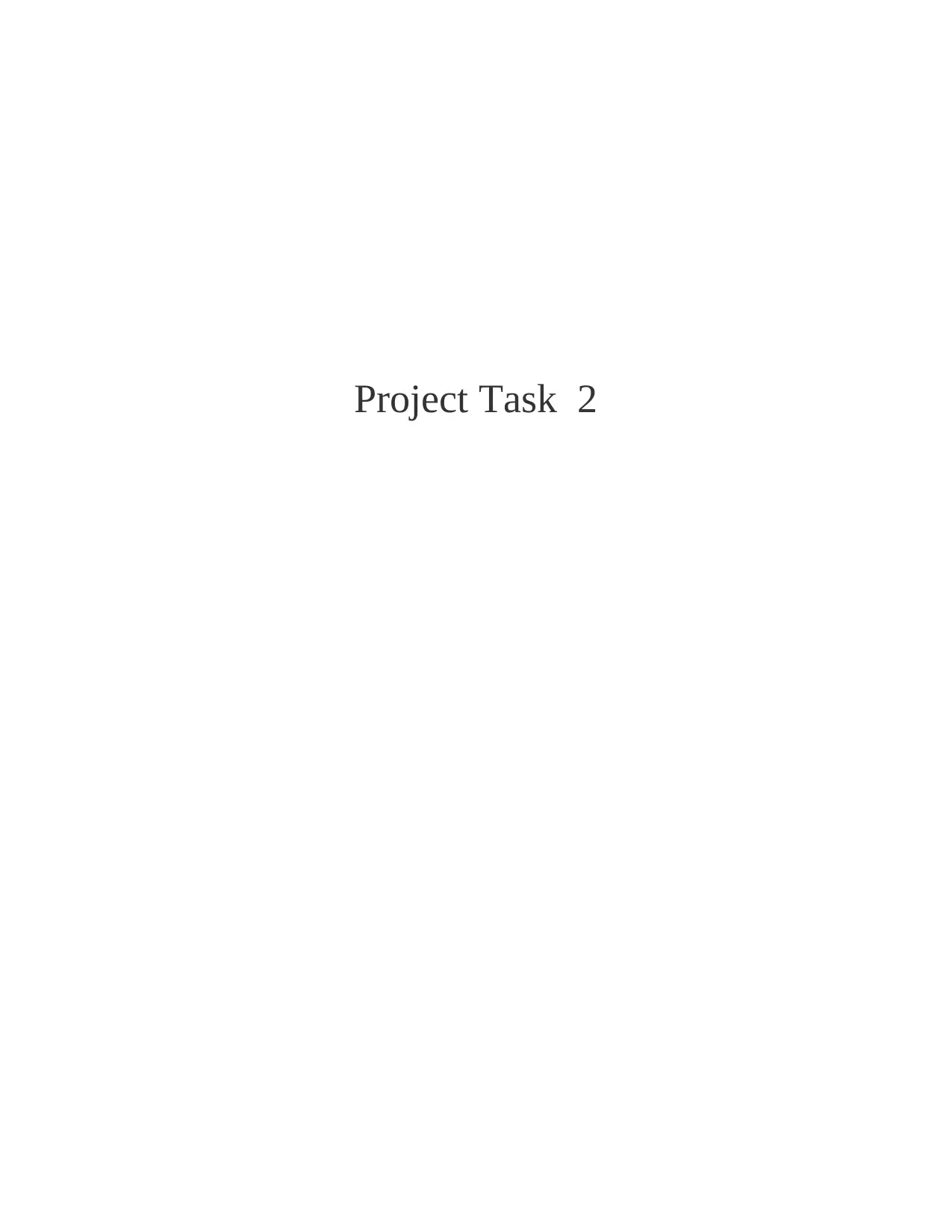
Project Task 2
Secure Best Marks with AI Grader
Need help grading? Try our AI Grader for instant feedback on your assignments.

Table of Contents
MAIN BODY..................................................................................................................................3
TASK 2............................................................................................................................................3
Organisational change.................................................................................................................3
Leadership styles.........................................................................................................................3
1...................................................................................................................................................3
2...................................................................................................................................................3
3...................................................................................................................................................3
4...................................................................................................................................................4
5...................................................................................................................................................4
Learning and communication......................................................................................................4
1...................................................................................................................................................4
2...................................................................................................................................................5
3...................................................................................................................................................5
4...................................................................................................................................................5
5...................................................................................................................................................6
6...................................................................................................................................................6
7...................................................................................................................................................6
8...................................................................................................................................................6
REFLECTION.................................................................................................................................7
REFERENCES................................................................................................................................1
MAIN BODY..................................................................................................................................3
TASK 2............................................................................................................................................3
Organisational change.................................................................................................................3
Leadership styles.........................................................................................................................3
1...................................................................................................................................................3
2...................................................................................................................................................3
3...................................................................................................................................................3
4...................................................................................................................................................4
5...................................................................................................................................................4
Learning and communication......................................................................................................4
1...................................................................................................................................................4
2...................................................................................................................................................5
3...................................................................................................................................................5
4...................................................................................................................................................5
5...................................................................................................................................................6
6...................................................................................................................................................6
7...................................................................................................................................................6
8...................................................................................................................................................6
REFLECTION.................................................................................................................................7
REFERENCES................................................................................................................................1
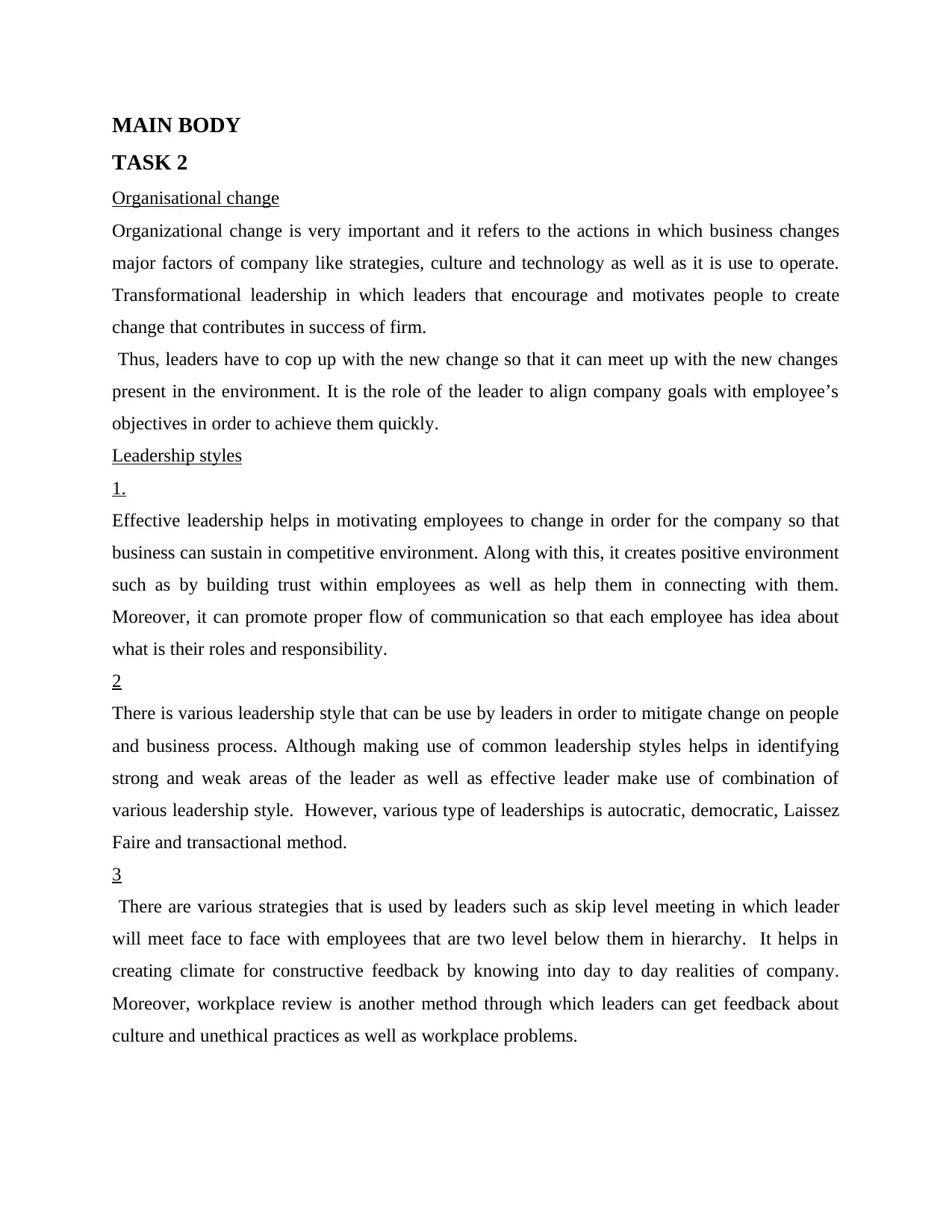
MAIN BODY
TASK 2
Organisational change
Organizational change is very important and it refers to the actions in which business changes
major factors of company like strategies, culture and technology as well as it is use to operate.
Transformational leadership in which leaders that encourage and motivates people to create
change that contributes in success of firm.
Thus, leaders have to cop up with the new change so that it can meet up with the new changes
present in the environment. It is the role of the leader to align company goals with employee’s
objectives in order to achieve them quickly.
Leadership styles
1.
Effective leadership helps in motivating employees to change in order for the company so that
business can sustain in competitive environment. Along with this, it creates positive environment
such as by building trust within employees as well as help them in connecting with them.
Moreover, it can promote proper flow of communication so that each employee has idea about
what is their roles and responsibility.
2
There is various leadership style that can be use by leaders in order to mitigate change on people
and business process. Although making use of common leadership styles helps in identifying
strong and weak areas of the leader as well as effective leader make use of combination of
various leadership style. However, various type of leaderships is autocratic, democratic, Laissez
Faire and transactional method.
3
There are various strategies that is used by leaders such as skip level meeting in which leader
will meet face to face with employees that are two level below them in hierarchy. It helps in
creating climate for constructive feedback by knowing into day to day realities of company.
Moreover, workplace review is another method through which leaders can get feedback about
culture and unethical practices as well as workplace problems.
TASK 2
Organisational change
Organizational change is very important and it refers to the actions in which business changes
major factors of company like strategies, culture and technology as well as it is use to operate.
Transformational leadership in which leaders that encourage and motivates people to create
change that contributes in success of firm.
Thus, leaders have to cop up with the new change so that it can meet up with the new changes
present in the environment. It is the role of the leader to align company goals with employee’s
objectives in order to achieve them quickly.
Leadership styles
1.
Effective leadership helps in motivating employees to change in order for the company so that
business can sustain in competitive environment. Along with this, it creates positive environment
such as by building trust within employees as well as help them in connecting with them.
Moreover, it can promote proper flow of communication so that each employee has idea about
what is their roles and responsibility.
2
There is various leadership style that can be use by leaders in order to mitigate change on people
and business process. Although making use of common leadership styles helps in identifying
strong and weak areas of the leader as well as effective leader make use of combination of
various leadership style. However, various type of leaderships is autocratic, democratic, Laissez
Faire and transactional method.
3
There are various strategies that is used by leaders such as skip level meeting in which leader
will meet face to face with employees that are two level below them in hierarchy. It helps in
creating climate for constructive feedback by knowing into day to day realities of company.
Moreover, workplace review is another method through which leaders can get feedback about
culture and unethical practices as well as workplace problems.
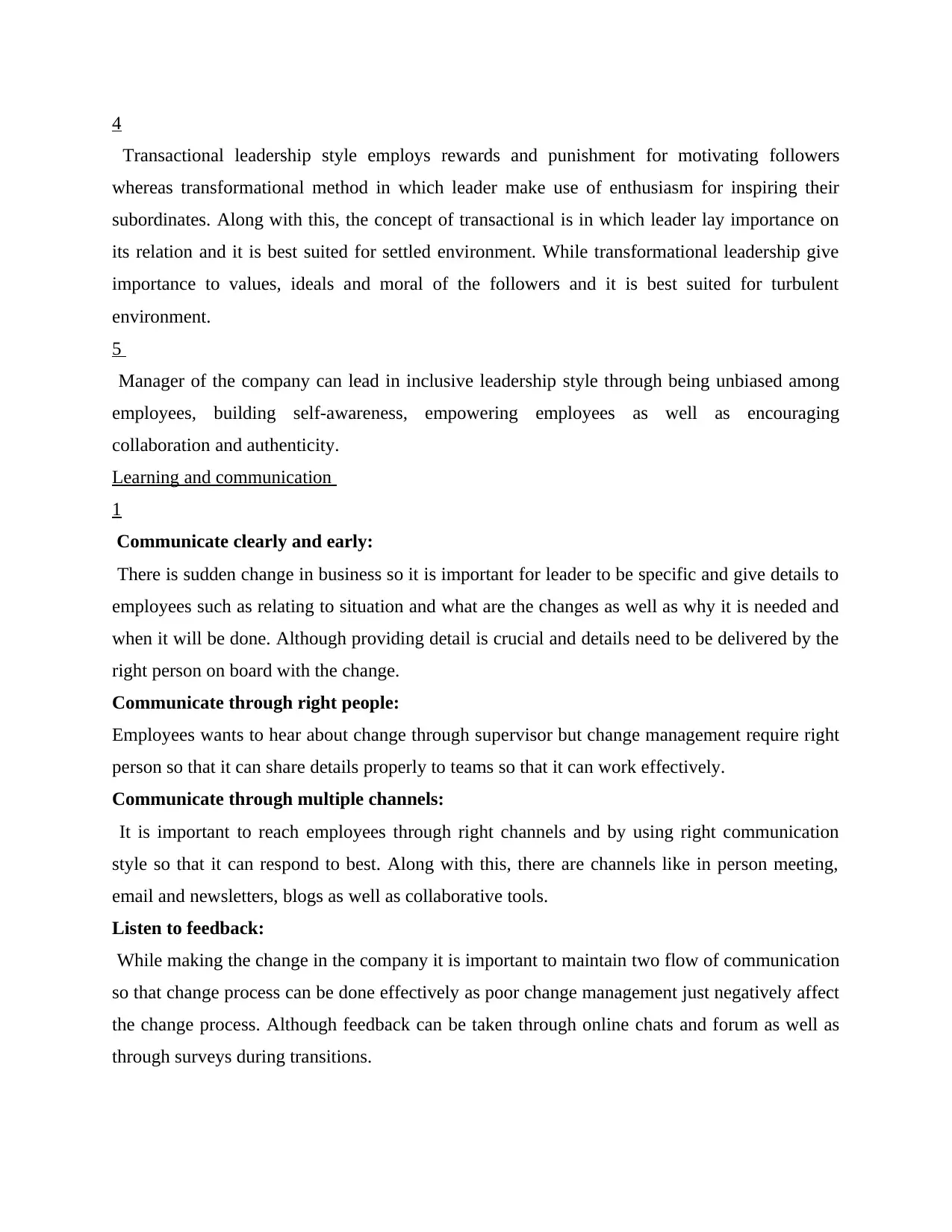
4
Transactional leadership style employs rewards and punishment for motivating followers
whereas transformational method in which leader make use of enthusiasm for inspiring their
subordinates. Along with this, the concept of transactional is in which leader lay importance on
its relation and it is best suited for settled environment. While transformational leadership give
importance to values, ideals and moral of the followers and it is best suited for turbulent
environment.
5
Manager of the company can lead in inclusive leadership style through being unbiased among
employees, building self-awareness, empowering employees as well as encouraging
collaboration and authenticity.
Learning and communication
1
Communicate clearly and early:
There is sudden change in business so it is important for leader to be specific and give details to
employees such as relating to situation and what are the changes as well as why it is needed and
when it will be done. Although providing detail is crucial and details need to be delivered by the
right person on board with the change.
Communicate through right people:
Employees wants to hear about change through supervisor but change management require right
person so that it can share details properly to teams so that it can work effectively.
Communicate through multiple channels:
It is important to reach employees through right channels and by using right communication
style so that it can respond to best. Along with this, there are channels like in person meeting,
email and newsletters, blogs as well as collaborative tools.
Listen to feedback:
While making the change in the company it is important to maintain two flow of communication
so that change process can be done effectively as poor change management just negatively affect
the change process. Although feedback can be taken through online chats and forum as well as
through surveys during transitions.
Transactional leadership style employs rewards and punishment for motivating followers
whereas transformational method in which leader make use of enthusiasm for inspiring their
subordinates. Along with this, the concept of transactional is in which leader lay importance on
its relation and it is best suited for settled environment. While transformational leadership give
importance to values, ideals and moral of the followers and it is best suited for turbulent
environment.
5
Manager of the company can lead in inclusive leadership style through being unbiased among
employees, building self-awareness, empowering employees as well as encouraging
collaboration and authenticity.
Learning and communication
1
Communicate clearly and early:
There is sudden change in business so it is important for leader to be specific and give details to
employees such as relating to situation and what are the changes as well as why it is needed and
when it will be done. Although providing detail is crucial and details need to be delivered by the
right person on board with the change.
Communicate through right people:
Employees wants to hear about change through supervisor but change management require right
person so that it can share details properly to teams so that it can work effectively.
Communicate through multiple channels:
It is important to reach employees through right channels and by using right communication
style so that it can respond to best. Along with this, there are channels like in person meeting,
email and newsletters, blogs as well as collaborative tools.
Listen to feedback:
While making the change in the company it is important to maintain two flow of communication
so that change process can be done effectively as poor change management just negatively affect
the change process. Although feedback can be taken through online chats and forum as well as
through surveys during transitions.
Secure Best Marks with AI Grader
Need help grading? Try our AI Grader for instant feedback on your assignments.
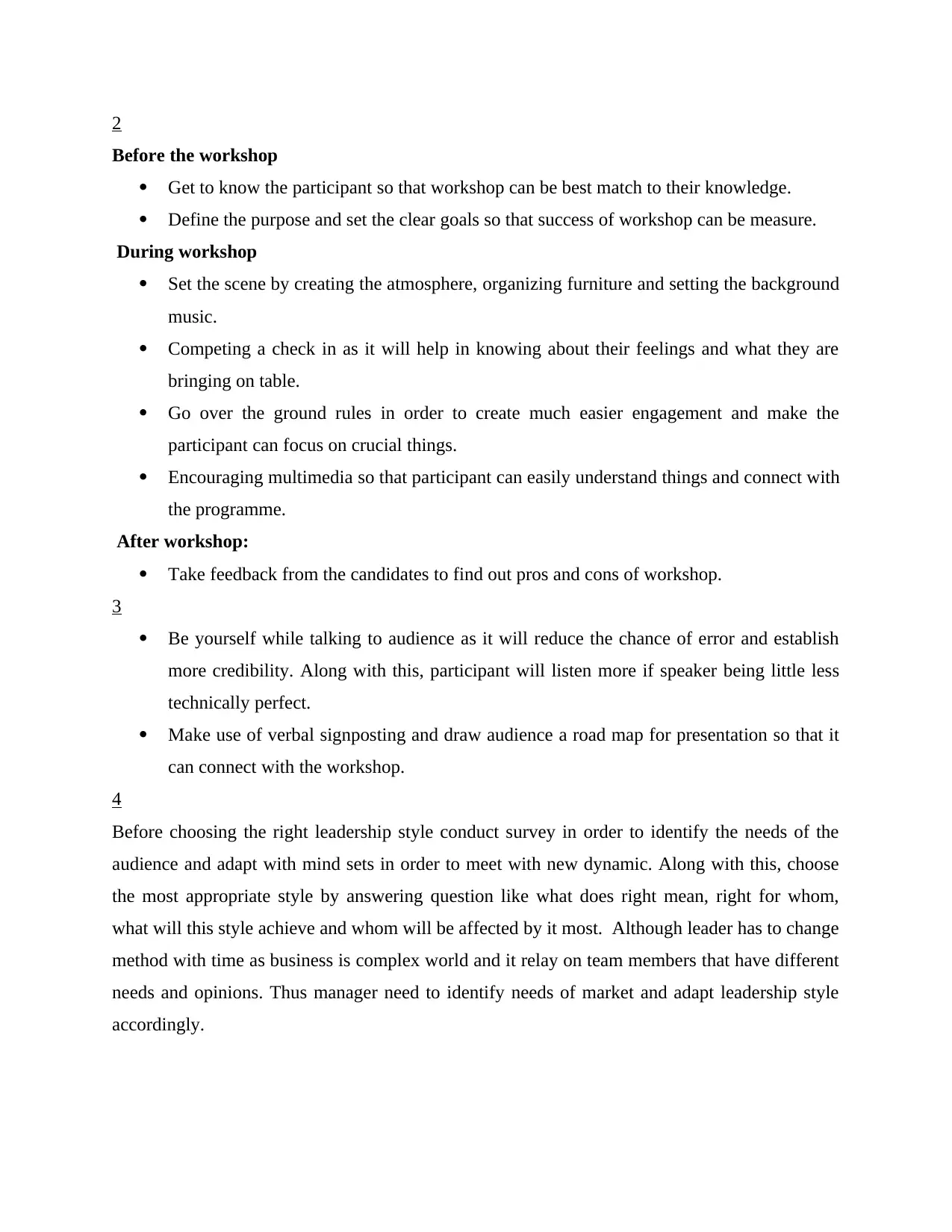
2
Before the workshop
Get to know the participant so that workshop can be best match to their knowledge.
Define the purpose and set the clear goals so that success of workshop can be measure.
During workshop
Set the scene by creating the atmosphere, organizing furniture and setting the background
music.
Competing a check in as it will help in knowing about their feelings and what they are
bringing on table.
Go over the ground rules in order to create much easier engagement and make the
participant can focus on crucial things.
Encouraging multimedia so that participant can easily understand things and connect with
the programme.
After workshop:
Take feedback from the candidates to find out pros and cons of workshop.
3
Be yourself while talking to audience as it will reduce the chance of error and establish
more credibility. Along with this, participant will listen more if speaker being little less
technically perfect.
Make use of verbal signposting and draw audience a road map for presentation so that it
can connect with the workshop.
4
Before choosing the right leadership style conduct survey in order to identify the needs of the
audience and adapt with mind sets in order to meet with new dynamic. Along with this, choose
the most appropriate style by answering question like what does right mean, right for whom,
what will this style achieve and whom will be affected by it most. Although leader has to change
method with time as business is complex world and it relay on team members that have different
needs and opinions. Thus manager need to identify needs of market and adapt leadership style
accordingly.
Before the workshop
Get to know the participant so that workshop can be best match to their knowledge.
Define the purpose and set the clear goals so that success of workshop can be measure.
During workshop
Set the scene by creating the atmosphere, organizing furniture and setting the background
music.
Competing a check in as it will help in knowing about their feelings and what they are
bringing on table.
Go over the ground rules in order to create much easier engagement and make the
participant can focus on crucial things.
Encouraging multimedia so that participant can easily understand things and connect with
the programme.
After workshop:
Take feedback from the candidates to find out pros and cons of workshop.
3
Be yourself while talking to audience as it will reduce the chance of error and establish
more credibility. Along with this, participant will listen more if speaker being little less
technically perfect.
Make use of verbal signposting and draw audience a road map for presentation so that it
can connect with the workshop.
4
Before choosing the right leadership style conduct survey in order to identify the needs of the
audience and adapt with mind sets in order to meet with new dynamic. Along with this, choose
the most appropriate style by answering question like what does right mean, right for whom,
what will this style achieve and whom will be affected by it most. Although leader has to change
method with time as business is complex world and it relay on team members that have different
needs and opinions. Thus manager need to identify needs of market and adapt leadership style
accordingly.

5
Judgement is an ability to collaborate personal skills with knowledge and sharing opinion
regarding it. It can be used in workshop in order to make accurate decision and deal with the
challenges properly. It can be applying through listening to audience and filter the information it
receives or head as it will contribute in reduce the chance of bad judgement. Moreover,
intelligence can be used by adopting good leadership style as it will help in dealing with the
changes and controlling audience.
6
Personal Power workshop will allow to monitor and control emotion and it will help in self-
determining leadership.
7
Using variety like multimedia and audios.
Keeping energy level high
Understanding needs of audience
PART B
REFLECTION
Leadership performance
During the training session I have analysed that I need to develop good communication skill so
that it can I easily share my thoughts and ideas in effective manner. Along with this, while
sharing my experience I was also regulating emotions so that other person can coordinate with
me as well as it was helpful in adopting good leadership style. Although I need to work on my
confidence as I get nervous while speaking sometimes and due to that the flow of information
get disturb (Bennett-Levy, 2019). Although while giving training I made use of normal English
so that each participant can get engaged in the session and I have also asked question in the
middle so that each of them listen carefully.
1.
During the training and session, my personal efficiency and opinions which are
developed by the learning and experience and it will help in growth and developments of
future career.
At the time of trainings and developments, I was utilized more resources to interact and
engage with staff and audience.
Judgement is an ability to collaborate personal skills with knowledge and sharing opinion
regarding it. It can be used in workshop in order to make accurate decision and deal with the
challenges properly. It can be applying through listening to audience and filter the information it
receives or head as it will contribute in reduce the chance of bad judgement. Moreover,
intelligence can be used by adopting good leadership style as it will help in dealing with the
changes and controlling audience.
6
Personal Power workshop will allow to monitor and control emotion and it will help in self-
determining leadership.
7
Using variety like multimedia and audios.
Keeping energy level high
Understanding needs of audience
PART B
REFLECTION
Leadership performance
During the training session I have analysed that I need to develop good communication skill so
that it can I easily share my thoughts and ideas in effective manner. Along with this, while
sharing my experience I was also regulating emotions so that other person can coordinate with
me as well as it was helpful in adopting good leadership style. Although I need to work on my
confidence as I get nervous while speaking sometimes and due to that the flow of information
get disturb (Bennett-Levy, 2019). Although while giving training I made use of normal English
so that each participant can get engaged in the session and I have also asked question in the
middle so that each of them listen carefully.
1.
During the training and session, my personal efficiency and opinions which are
developed by the learning and experience and it will help in growth and developments of
future career.
At the time of trainings and developments, I was utilized more resources to interact and
engage with staff and audience.
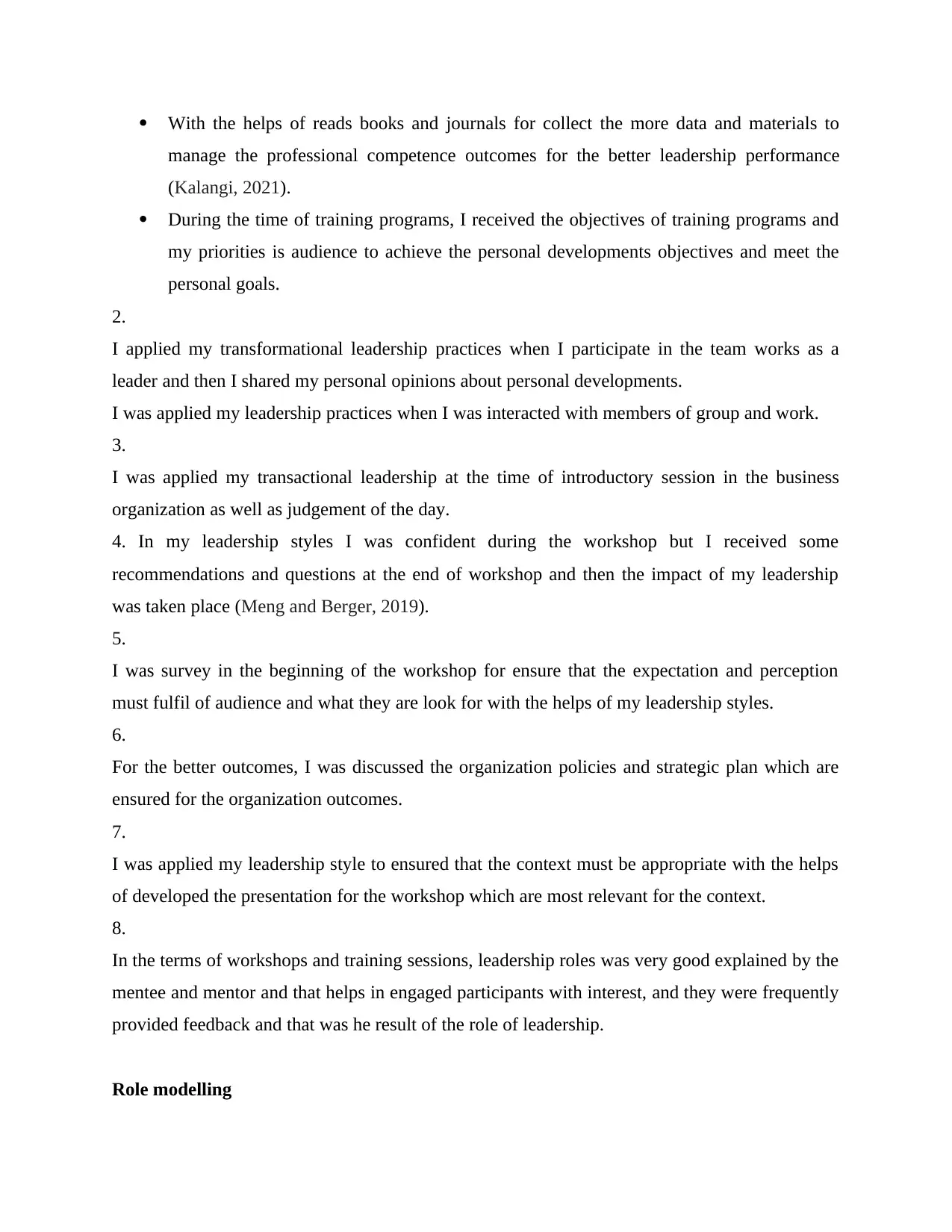
With the helps of reads books and journals for collect the more data and materials to
manage the professional competence outcomes for the better leadership performance
(Kalangi, 2021).
During the time of training programs, I received the objectives of training programs and
my priorities is audience to achieve the personal developments objectives and meet the
personal goals.
2.
I applied my transformational leadership practices when I participate in the team works as a
leader and then I shared my personal opinions about personal developments.
I was applied my leadership practices when I was interacted with members of group and work.
3.
I was applied my transactional leadership at the time of introductory session in the business
organization as well as judgement of the day.
4. In my leadership styles I was confident during the workshop but I received some
recommendations and questions at the end of workshop and then the impact of my leadership
was taken place (Meng and Berger, 2019).
5.
I was survey in the beginning of the workshop for ensure that the expectation and perception
must fulfil of audience and what they are look for with the helps of my leadership styles.
6.
For the better outcomes, I was discussed the organization policies and strategic plan which are
ensured for the organization outcomes.
7.
I was applied my leadership style to ensured that the context must be appropriate with the helps
of developed the presentation for the workshop which are most relevant for the context.
8.
In the terms of workshops and training sessions, leadership roles was very good explained by the
mentee and mentor and that helps in engaged participants with interest, and they were frequently
provided feedback and that was he result of the role of leadership.
Role modelling
manage the professional competence outcomes for the better leadership performance
(Kalangi, 2021).
During the time of training programs, I received the objectives of training programs and
my priorities is audience to achieve the personal developments objectives and meet the
personal goals.
2.
I applied my transformational leadership practices when I participate in the team works as a
leader and then I shared my personal opinions about personal developments.
I was applied my leadership practices when I was interacted with members of group and work.
3.
I was applied my transactional leadership at the time of introductory session in the business
organization as well as judgement of the day.
4. In my leadership styles I was confident during the workshop but I received some
recommendations and questions at the end of workshop and then the impact of my leadership
was taken place (Meng and Berger, 2019).
5.
I was survey in the beginning of the workshop for ensure that the expectation and perception
must fulfil of audience and what they are look for with the helps of my leadership styles.
6.
For the better outcomes, I was discussed the organization policies and strategic plan which are
ensured for the organization outcomes.
7.
I was applied my leadership style to ensured that the context must be appropriate with the helps
of developed the presentation for the workshop which are most relevant for the context.
8.
In the terms of workshops and training sessions, leadership roles was very good explained by the
mentee and mentor and that helps in engaged participants with interest, and they were frequently
provided feedback and that was he result of the role of leadership.
Role modelling
Paraphrase This Document
Need a fresh take? Get an instant paraphrase of this document with our AI Paraphraser
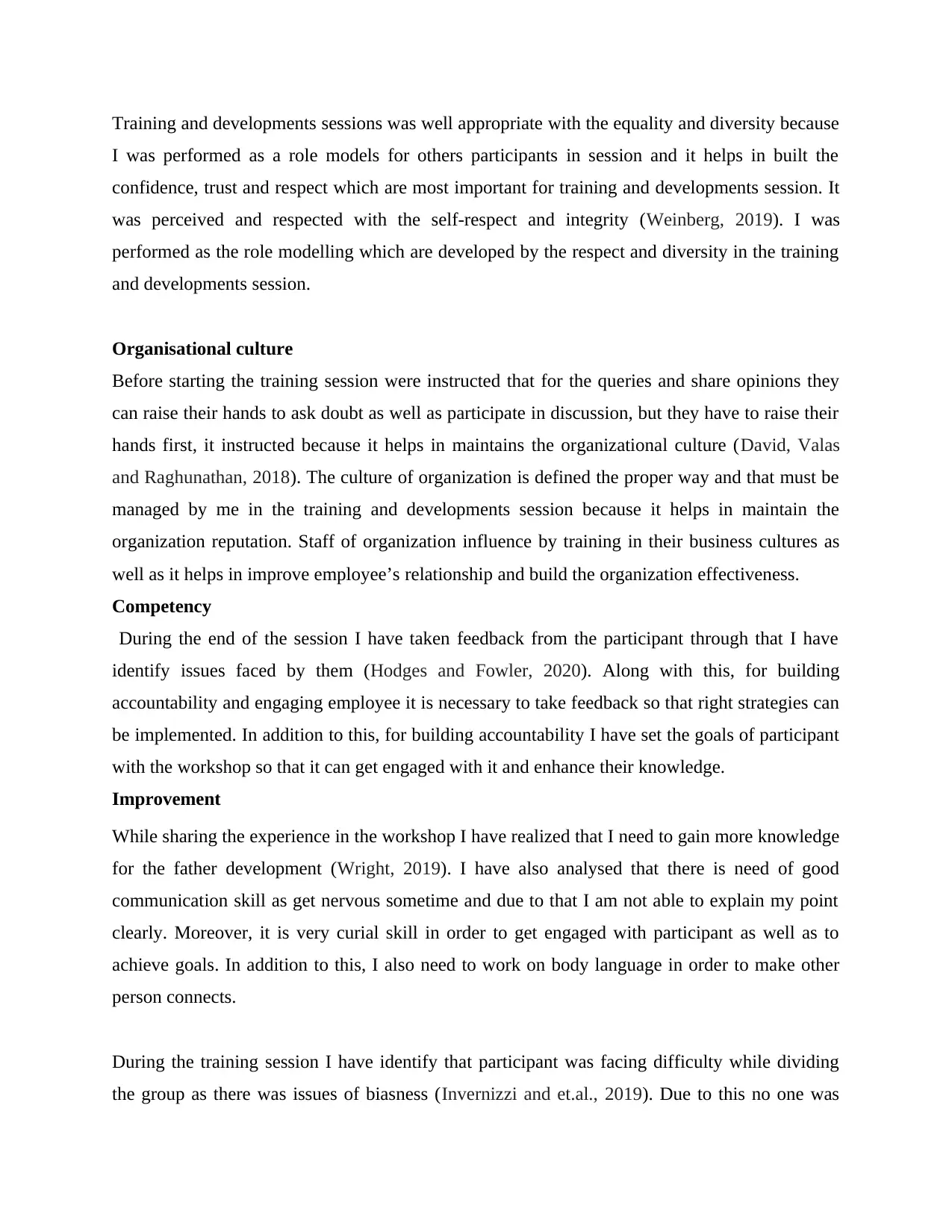
Training and developments sessions was well appropriate with the equality and diversity because
I was performed as a role models for others participants in session and it helps in built the
confidence, trust and respect which are most important for training and developments session. It
was perceived and respected with the self-respect and integrity (Weinberg, 2019). I was
performed as the role modelling which are developed by the respect and diversity in the training
and developments session.
Organisational culture
Before starting the training session were instructed that for the queries and share opinions they
can raise their hands to ask doubt as well as participate in discussion, but they have to raise their
hands first, it instructed because it helps in maintains the organizational culture (David, Valas
and Raghunathan, 2018). The culture of organization is defined the proper way and that must be
managed by me in the training and developments session because it helps in maintain the
organization reputation. Staff of organization influence by training in their business cultures as
well as it helps in improve employee’s relationship and build the organization effectiveness.
Competency
During the end of the session I have taken feedback from the participant through that I have
identify issues faced by them (Hodges and Fowler, 2020). Along with this, for building
accountability and engaging employee it is necessary to take feedback so that right strategies can
be implemented. In addition to this, for building accountability I have set the goals of participant
with the workshop so that it can get engaged with it and enhance their knowledge.
Improvement
While sharing the experience in the workshop I have realized that I need to gain more knowledge
for the father development (Wright, 2019). I have also analysed that there is need of good
communication skill as get nervous sometime and due to that I am not able to explain my point
clearly. Moreover, it is very curial skill in order to get engaged with participant as well as to
achieve goals. In addition to this, I also need to work on body language in order to make other
person connects.
During the training session I have identify that participant was facing difficulty while dividing
the group as there was issues of biasness (Invernizzi and et.al., 2019). Due to this no one was
I was performed as a role models for others participants in session and it helps in built the
confidence, trust and respect which are most important for training and developments session. It
was perceived and respected with the self-respect and integrity (Weinberg, 2019). I was
performed as the role modelling which are developed by the respect and diversity in the training
and developments session.
Organisational culture
Before starting the training session were instructed that for the queries and share opinions they
can raise their hands to ask doubt as well as participate in discussion, but they have to raise their
hands first, it instructed because it helps in maintains the organizational culture (David, Valas
and Raghunathan, 2018). The culture of organization is defined the proper way and that must be
managed by me in the training and developments session because it helps in maintain the
organization reputation. Staff of organization influence by training in their business cultures as
well as it helps in improve employee’s relationship and build the organization effectiveness.
Competency
During the end of the session I have taken feedback from the participant through that I have
identify issues faced by them (Hodges and Fowler, 2020). Along with this, for building
accountability and engaging employee it is necessary to take feedback so that right strategies can
be implemented. In addition to this, for building accountability I have set the goals of participant
with the workshop so that it can get engaged with it and enhance their knowledge.
Improvement
While sharing the experience in the workshop I have realized that I need to gain more knowledge
for the father development (Wright, 2019). I have also analysed that there is need of good
communication skill as get nervous sometime and due to that I am not able to explain my point
clearly. Moreover, it is very curial skill in order to get engaged with participant as well as to
achieve goals. In addition to this, I also need to work on body language in order to make other
person connects.
During the training session I have identify that participant was facing difficulty while dividing
the group as there was issues of biasness (Invernizzi and et.al., 2019). Due to this no one was
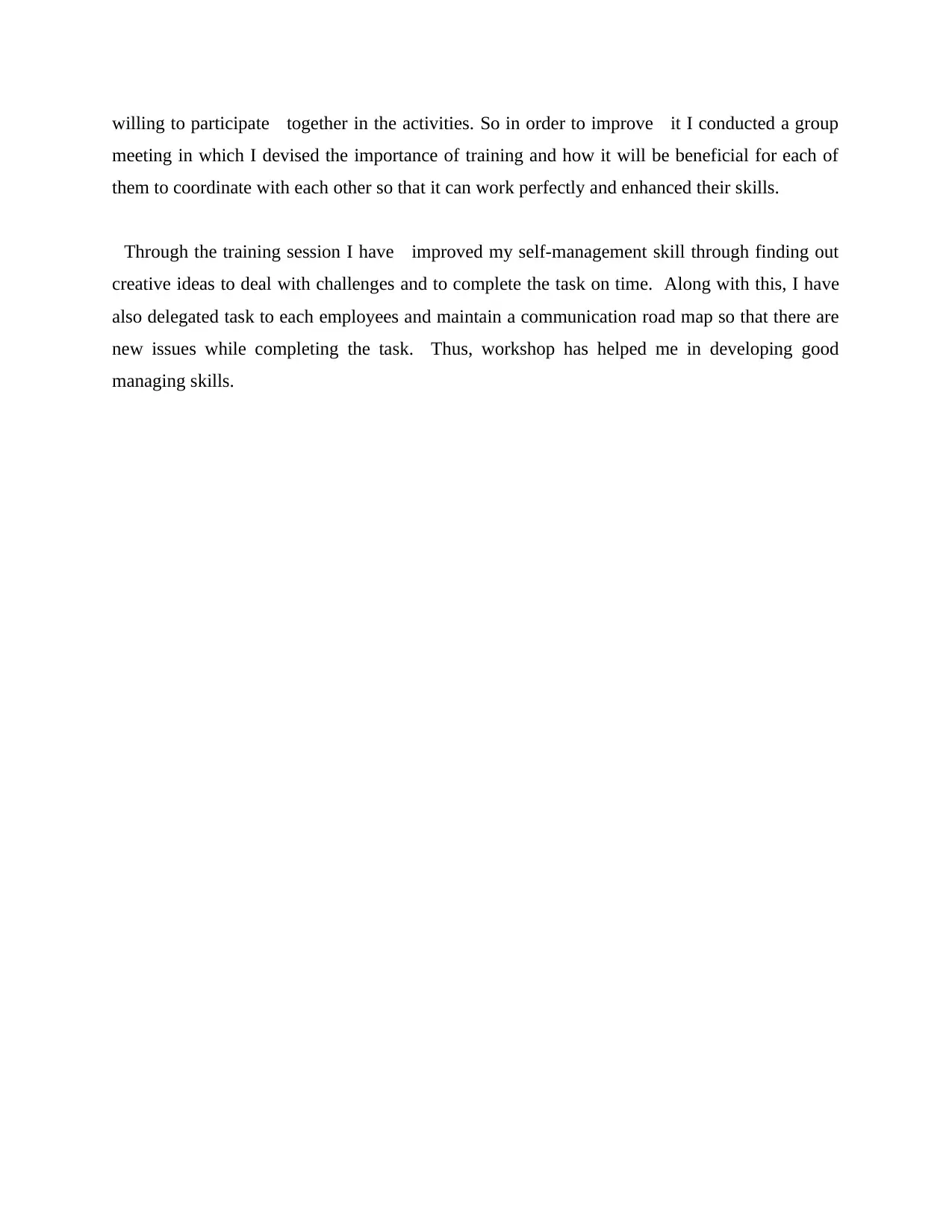
willing to participate together in the activities. So in order to improve it I conducted a group
meeting in which I devised the importance of training and how it will be beneficial for each of
them to coordinate with each other so that it can work perfectly and enhanced their skills.
Through the training session I have improved my self-management skill through finding out
creative ideas to deal with challenges and to complete the task on time. Along with this, I have
also delegated task to each employees and maintain a communication road map so that there are
new issues while completing the task. Thus, workshop has helped me in developing good
managing skills.
meeting in which I devised the importance of training and how it will be beneficial for each of
them to coordinate with each other so that it can work perfectly and enhanced their skills.
Through the training session I have improved my self-management skill through finding out
creative ideas to deal with challenges and to complete the task on time. Along with this, I have
also delegated task to each employees and maintain a communication road map so that there are
new issues while completing the task. Thus, workshop has helped me in developing good
managing skills.

REFERENCES
Books and journals
Bennett-Levy, J., 2019. Why therapists should walk the talk: The theoretical and empirical case
for personal practice in therapist training and professional development. Journal of
behavior therapy and experimental psychiatry. 62. pp.133-145.
David, S.N., Valas, S. and Raghunathan, R., 2018. Assessing organization culture–a review on
the ocai instrument. In International Conference on Management and Information
Systems (Vol. 21, pp. 182-188).
Hodges, C. B. and Fowler, D. J., 2020. The COVID-19 Crisis and Faculty Members in Higher
Education: From Emergency Remote Teaching to Better Teaching through
Reflection. International Journal of Multidisciplinary Perspectives in Higher
Education.5(1). pp.118-122.
Invernizzi, P. L. and et.al., 2019. Multi-teaching styles approach and active reflection:
Effectiveness in improving fitness level, motor competence, enjoyment, amount of
physical activity, and effects on the perception of physical education lessons in primary
school children. Sustainability. 11(2).p.405.
Kalangi, S., and et.al., 2021. Principal Leadership Performance: Indonesian Case. The
International Journal of Social Sciences World (TIJOSSW). 3(2). pp.74-89.
Meng, J. and Berger, B.K., 2019. The impact of organizational culture and leadership
performance on PR professionals’ job satisfaction: Testing the joint mediating effects of
engagement and trust. Public Relations Review. 45(1). pp.64-75.
Weinberg, F.J., 2019. How and when is role modeling effective? The influence of mentee
professional identity on mentoring dynamics and personal learning outcomes. Group &
Wright, P. I., 2019. Cultural humility in the practice of applied behavior analysis. Behavior
Analysis in Practice. 12(4). pp.805-809.
1
Books and journals
Bennett-Levy, J., 2019. Why therapists should walk the talk: The theoretical and empirical case
for personal practice in therapist training and professional development. Journal of
behavior therapy and experimental psychiatry. 62. pp.133-145.
David, S.N., Valas, S. and Raghunathan, R., 2018. Assessing organization culture–a review on
the ocai instrument. In International Conference on Management and Information
Systems (Vol. 21, pp. 182-188).
Hodges, C. B. and Fowler, D. J., 2020. The COVID-19 Crisis and Faculty Members in Higher
Education: From Emergency Remote Teaching to Better Teaching through
Reflection. International Journal of Multidisciplinary Perspectives in Higher
Education.5(1). pp.118-122.
Invernizzi, P. L. and et.al., 2019. Multi-teaching styles approach and active reflection:
Effectiveness in improving fitness level, motor competence, enjoyment, amount of
physical activity, and effects on the perception of physical education lessons in primary
school children. Sustainability. 11(2).p.405.
Kalangi, S., and et.al., 2021. Principal Leadership Performance: Indonesian Case. The
International Journal of Social Sciences World (TIJOSSW). 3(2). pp.74-89.
Meng, J. and Berger, B.K., 2019. The impact of organizational culture and leadership
performance on PR professionals’ job satisfaction: Testing the joint mediating effects of
engagement and trust. Public Relations Review. 45(1). pp.64-75.
Weinberg, F.J., 2019. How and when is role modeling effective? The influence of mentee
professional identity on mentoring dynamics and personal learning outcomes. Group &
Wright, P. I., 2019. Cultural humility in the practice of applied behavior analysis. Behavior
Analysis in Practice. 12(4). pp.805-809.
1
1 out of 10
Related Documents
Your All-in-One AI-Powered Toolkit for Academic Success.
+13062052269
info@desklib.com
Available 24*7 on WhatsApp / Email
![[object Object]](/_next/static/media/star-bottom.7253800d.svg)
Unlock your academic potential
© 2024 | Zucol Services PVT LTD | All rights reserved.




